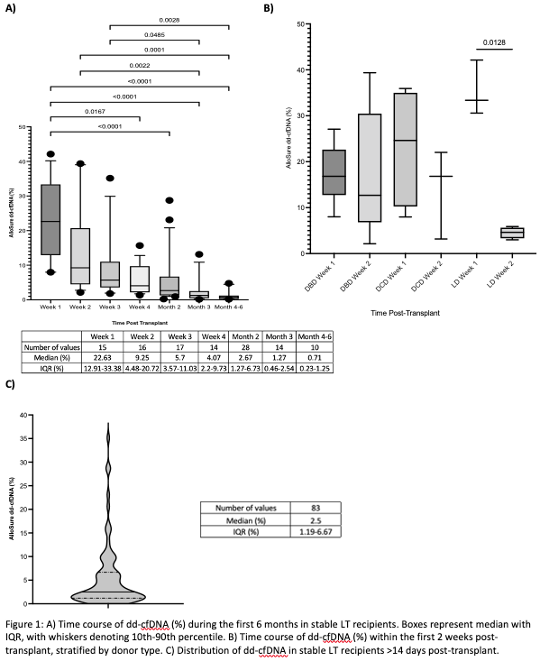Baseline Levels and Early Post-Transplant Kinetics of Donor-Derived Cell-Free DNA Following Liver Transplantation
1Mount Sinai Medical Center, New York, NY, 2University of Iowa, Iowa City, IA, 3CareDx, South San Francisco, CA, 4Tampa General Hospital, Tampa, FL
Meeting: 2022 American Transplant Congress
Abstract number: 1575
Keywords: Graft function, Liver transplantation, Rejection
Topic: Basic Science » Basic Clinical Science » 17 - Biomarkers: Clinical Outcomes
Session Information
Session Name: Biomarkers: Clinical Outcomes
Session Type: Poster Abstract
Date: Tuesday, June 7, 2022
Session Time: 7:00pm-8:00pm
 Presentation Time: 7:00pm-8:00pm
Presentation Time: 7:00pm-8:00pm
Location: Hynes Halls C & D
*Purpose: Non-invasive biomarkers in liver transplant (LT) are needed to improve detection of allograft injury in routine surveillance and during immunosuppression modulation, prior to the development of graft dysfunction. Donor-derived cell-free DNA (dd-cfDNA) as an injury marker can quantify subclinical inflammation and molecular injury in solid organ transplant (SOT) recipients. Here, we describe the baseline levels and early post-transplant (PT) kinetics of dd-cfDNA in LT.
*Methods: LT recipients from the prospective, multicenter Molecular Assessment and Profiling of Liver transplant rEcipients (MAPLE) study (NCT 04793360) were examined. All patients had serial dd-cfDNA (AlloSure; CareDx) levels monitored PT in tandem with routine surveillance, beginning as early as day 1 post-operatively.
*Results: 31 stable LT recipients were identified, with 114 dd-cfDNA draws within 6 months PT. Stability was defined as absence of graft dysfunction (>50% change in LFTs), acute rejection or infection. Patients included both deceased and living donor LTs (Table 1). dd-cfDNA was significantly elevated in the first week PT (median 22.3%, IQR 12.91-33.38%) and declined rapidly over two weeks in stable patients (Figure 1A). Living donor LT showed a significant decline in median dd-cfDNA between week 1 and 2 PT (33.8% and 4.6% respectively, p=0.01). The median level of dd-cfDNA in stable LT recipients (n=31) >14 days after LT was 2.5% (IQR 1.19-6.67%, Figure 1B).
*Conclusions: LT recipients demonstrate an exponential decay of dd-cfDNA following transplantation, which may reflect recovery from ischemia reperfusion injury. This trend appeared accelerated in living donor LT recipients. After 14 days PT, LT recipients have low levels of circulating dd-cfDNA in the absence of rejection, graft dysfunction or infection. Although the absolute percentage of dd-cfDNA in stable LT recipients differ from other organs, the pattern of distribution remains consistent. The MAPLE study will continue to assess the ability of cfDNA to identify alloimmune injury non-invasively after LT.
To cite this abstract in AMA style:
Florman S, Axelrod D, Miles J, Vaskova E, Kilam D, Dhanireddy K, Subramanian V. Baseline Levels and Early Post-Transplant Kinetics of Donor-Derived Cell-Free DNA Following Liver Transplantation [abstract]. Am J Transplant. 2022; 22 (suppl 3). https://atcmeetingabstracts.com/abstract/baseline-levels-and-early-post-transplant-kinetics-of-donor-derived-cell-free-dna-following-liver-transplantation/. Accessed January 1, 2026.« Back to 2022 American Transplant Congress


